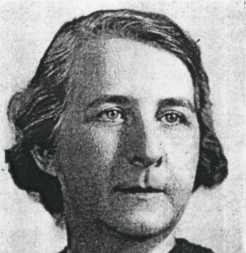


Published on May 04, 2021
 Within Eastern Connecticut State University’s Archives and Special Collections is a rare resource: the Helena Miller Collection. This collection ns over sixty letters and newsletters from the World War II era (1939-1945) exchanged between the dean and faculty member Dr. Helena Miller and students drafted into the military during the war. Dr. Helena Miller was Dean of Women at Willimantic State Teacher’s College (the predecessor of Eastern Connecticut State University) and her collection serves as an excellent snapshot for a crucial moment in American history. Researchers in the Helena Miller Collection will find an equal balance between historical facts and emotional stories within each of the surviving letters.
Within Eastern Connecticut State University’s Archives and Special Collections is a rare resource: the Helena Miller Collection. This collection ns over sixty letters and newsletters from the World War II era (1939-1945) exchanged between the dean and faculty member Dr. Helena Miller and students drafted into the military during the war. Dr. Helena Miller was Dean of Women at Willimantic State Teacher’s College (the predecessor of Eastern Connecticut State University) and her collection serves as an excellent snapshot for a crucial moment in American history. Researchers in the Helena Miller Collection will find an equal balance between historical facts and emotional stories within each of the surviving letters.
Born in 1888, Helena Miller spent her childhood in Connecticut. She attended Connecticut public schools until she graduated from high school, at which point she moved to Massachusetts to attend Smith College. After earning her Bachelor’s (1910) and Master’s (1912) degrees, Miller returned home to Connecticut to seek employment. She found a job working for the department of the State Board of Education in Connecticut’s State Capitol. In addition to holding a full-time job, Helena Miller pursued and earned her PhD at Yale. Her efforts were recognized in a public announcement from a June 20th, 1928 edition of The Hartford Courant. Dr. Helena Miller then obtained a job working at the Willimantic State Teachers College (WSTC). She began as a teaching Professor and eventually became Dean of Women. Her entire WSTC career spanned the period between 1933 and 1945, intersecting with the duration of World War II (1939-1945). Out of a desire to keep drafted students up-to-date with news regarding WSTC, Dr. Helena Miller sent to them copies of a school news publication she called “The Dean’s Den.” In return, she received letters back from deployed students, which created the collection ECSU has today. As World War II reached its end in the later months of 1945, Dr. Miller retired and spent the rest of her life in Wethersfield, Connecticut. She remained, however, an integral part of Willimantic’s community until she passed away on July 30th, 1959. Her achievements and her compassion for students serving in World War II are forever preserved in the Helena Miller Collection.
The Helena Miller Collection covers a three-year time period from 1943 to 1945 and is divided into two series: Correspondence and Newsletters. Correspondence contains 69 letters from students, and Newsletters contains 17 publications of “The Dean’s Den.” These newsletters include general news about WSTC as well as news about the war, classmates, and the Willimantic community. Dr. Helena Miller’s newsletters brought comfort to students away from home, and gave them hope for their return. While some students were graduates of the college, most of them left just before graduation with the goal to return after the war and obtain their degrees. Dr. Miller’s close relationship with her students is documented in her letters. An excellent example of this bond is seen in Ernest E. Dickson’s letter dated December 2, 1943. He writes, “Dr. Miller, I do appreciate your paper because I know so many of the people the paper mentions. I hope you’ll continue to send me the paper even though I am expecting to get shipped out very soon…” (Dickson, letter 11). Dickson’s sentiments toward Dr. Miller and “The Dean’s Den,” are echoed in the many letters shared by his comrades.
The Helena Miller Collection offers many possibilities for research as it provides two perspectives to history. The first is informational: the letters offer a first-person look into World War II. For example, readers will find real accounts of D-Day and Normandy within these letters, as well as discussions about rations, bombings, and war strategy. The second perspective offered by the Helena Miller Collection is emotional: readers will discover very personal experiences of the letter writers and soldiers: they enjoyed birthday cake (Ruth Jones, letter 44), worried about balding (Howard Schepart, letter 57), and missed snowball fights with their friends (Jack Selavka, letter 62). Students and researchers alike will find sorrow, joy, and triumph within these stories, and hopefully share in the humanity the letters express. The Helena Miller Collection is both a source for World War II history and a testament to the human spirit.
Written by Claire Lavarreda